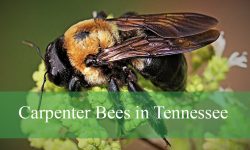Have you ever stopped to notice the soft cooing of a dove in North Carolina? From busy city streets to quiet farmlands, these birds are part of everyday life, yet many people don’t realize just how many different species live here—or even pass through as rare visitors.
In this article, we’ll uncover 8 types of doves found in the state, ranging from the common Mourning Dove to the once-mythical Passenger Pigeon. Each has its own story, appearance, and behavior, making North Carolina a surprisingly rich place for dove watching.
Different Types of Doves Found in North Carolina
Mourning Dove (Zenaida macroura)

The Mourning Dove is the most common dove species in North Carolina, known for its soft gray-brown plumage with black spots on the wings and a long, pointed tail edged in white. Adults measure around 9 to 13 inches in length with a wingspan of up to 18 inches, making them medium-sized among dove species. Their streamlined body and graceful flight pattern make them easy to identify in open fields, suburban areas, and woodland edges.
Behaviorally, Mourning Doves are often seen perched on telephone wires or foraging in flocks on the ground. They primarily feed on seeds, which make up over 90% of their diet, and they swallow grit to aid digestion. Their flight is rapid and direct, with sharp wingbeats that create a whistling sound. Mourning Doves are also known for their strong homing instincts and long seasonal migrations.
Their song is a soft, mournful cooing that gives the species its name, often described as a haunting “coo-OO-oo.” During breeding season, males perform aerial displays and coo loudly to attract females. Nests are flimsy platforms of twigs placed in shrubs, trees, or even on man-made structures. Females typically lay two white eggs, and both parents share incubation duties.
A fun fact about Mourning Doves is that they are one of the most hunted game birds in North America, yet their populations remain abundant due to their high reproductive rate—pairs can raise up to six broods in a single season in warmer regions like North Carolina.
Rock Pigeon (Columba livia)
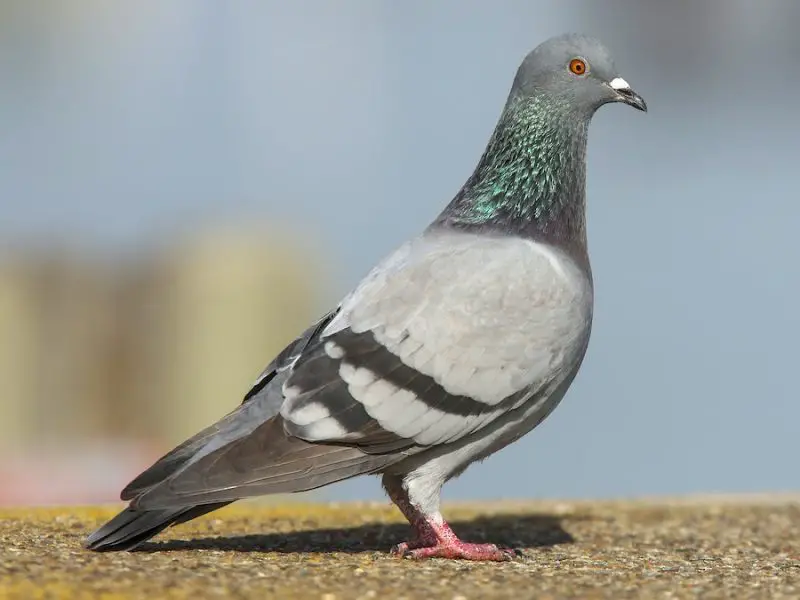
The Rock Pigeon, often simply called the “pigeon,” is a familiar bird in North Carolina’s cities, towns, and rural areas. They have a chunky body, short legs, and a small head, usually displaying bluish-gray plumage with two dark wing bars and iridescent feathers around the neck. However, they show a wide variety of colors due to domestication and hybridization, ranging from pure white to mottled patterns.
These pigeons are social and often form large flocks, especially in urban environments where food is abundant. Their diet consists mainly of seeds, grains, and discarded human food scraps, making them well-adapted to city living. Rock Pigeons are strong fliers, capable of reaching speeds of up to 70 miles per hour, and have been historically valued for their homing ability.
Their vocalizations are low-pitched coos, with males often bowing and fanning their tails while cooing to court females. Rock Pigeons nest on building ledges, under bridges, or on cliffs, closely resembling their natural cliff-dwelling habitats. They breed year-round, laying two white eggs per clutch, and both parents care for the young by feeding them “pigeon milk,” a nutrient-rich secretion.
A fun fact about Rock Pigeons is that they were once used as messenger birds due to their remarkable homing ability, carrying critical messages during wars. Today, they continue to fascinate people in racing and hobby breeding circles.
Eurasian Collared-Dove (Streptopelia decaocto)
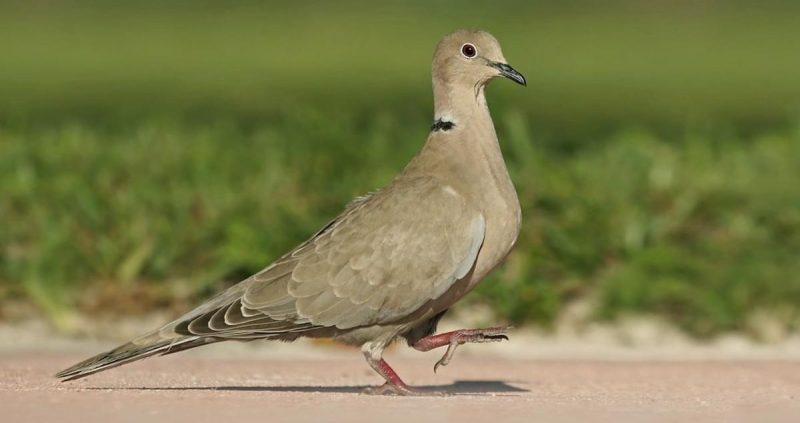
The Eurasian Collared-Dove is a relatively recent arrival in North Carolina but has rapidly spread across the state. This medium-sized dove is pale gray with a distinct black collar edged in white at the back of its neck, which makes identification straightforward. Its tail is square-tipped, and its flight shows broad, rounded wings with white edges. Adults measure about 12 to 14 inches long with a wingspan up to 18 inches.
These doves are highly adaptable and thrive in suburban areas, farmland, and near human habitation. They feed mainly on seeds and grains, often visiting backyard feeders. Their flight is strong and direct, and they are frequently seen perched on power lines or rooftops. Unlike some migratory doves, Eurasian Collared-Doves are year-round residents once they establish themselves.
Their song is a distinctive three-part cooing phrase often repeated multiple times, sounding like “coo-COO-coo.” During courtship, males perform display flights and give exaggerated wing claps. Nests are simple twig structures placed in trees, shrubs, or on buildings. Females typically lay two eggs, and breeding can occur throughout much of the year.
A fun fact about Eurasian Collared-Doves is that their North American population began from a small group that escaped captivity in the Bahamas in the 1970s. Since then, they have spread rapidly across the continent, including throughout North Carolina.
White-winged Dove (Zenaida asiatica)

The White-winged Dove is less common in North Carolina but can occasionally be spotted, especially during migration. This medium-to-large dove is recognized by its grayish-brown body, striking white wing patches visible in flight, and a distinctive blue ring around its red eyes. Adults measure about 11 to 12 inches in length with a wingspan of up to 18 inches.
They typically inhabit desert regions and open woodlands in the southern United States but occasionally wander into North Carolina. Their diet consists largely of seeds and grains, with a preference for agricultural crops like corn and sunflower. They also feed on fruits and berries when available. These doves are strong fliers, with rapid wingbeats and direct flight patterns.
Their call is a distinctive “who-cooks-for-you” cooing sound, which can carry over long distances. During courtship, males pursue females in fluttering display flights. They usually nest in trees or shrubs, constructing loose twig platforms. Like other doves, they lay two white eggs, and both parents share in raising the young.
A fun fact about White-winged Doves is that they play a crucial role in the pollination of the saguaro cactus in the southwestern U.S. While rare in North Carolina, their occasional presence adds excitement for birdwatchers hoping to spot an uncommon visitor.
Band-tailed Pigeon (Patagioenas fasciata)
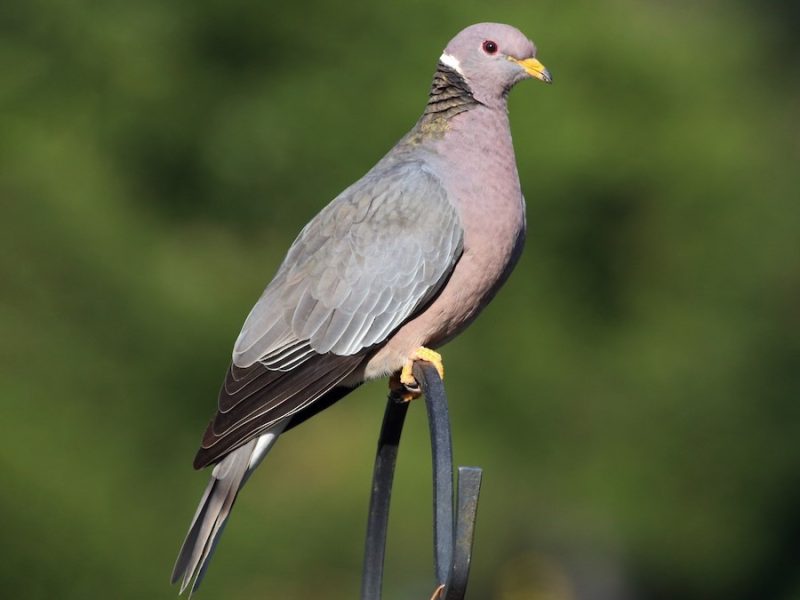
The Band-tailed Pigeon is a rare visitor to North Carolina, usually spotted only during unusual migratory movements. This large dove resembles the Rock Pigeon but is sleeker, with a long tail marked by a pale gray band near the tip. Adults measure about 13 to 16 inches in length with a wingspan of up to 26 inches, making them one of the largest pigeon species in North America. Their plumage is soft gray with a subtle purple wash on the head and breast, and they show a distinctive white crescent on the nape.
Band-tailed Pigeons prefer forested habitats, particularly mountainous woodlands and coniferous forests in the western U.S., but stray individuals occasionally appear in the East. Their diet is diverse, including acorns, berries, seeds, and cultivated grains. They often forage in flocks, moving between feeding and roosting areas with swift, direct flight.
Their call is a low, owl-like cooing, quite different from the familiar Mourning Dove’s mournful tone. Breeding takes place in forested regions, where they build flimsy nests of twigs on tree branches. Females usually lay just one egg, which is unusual among pigeons and doves. Both parents participate in raising the young, feeding them crop “pigeon milk.”
A fun fact about Band-tailed Pigeons is that they are considered the closest living relatives of the now-extinct Passenger Pigeon, sharing both physical and behavioral similarities. Birdwatchers in North Carolina are always excited by the rare chance to see one.
Common Ground Dove (Columbina passerina)
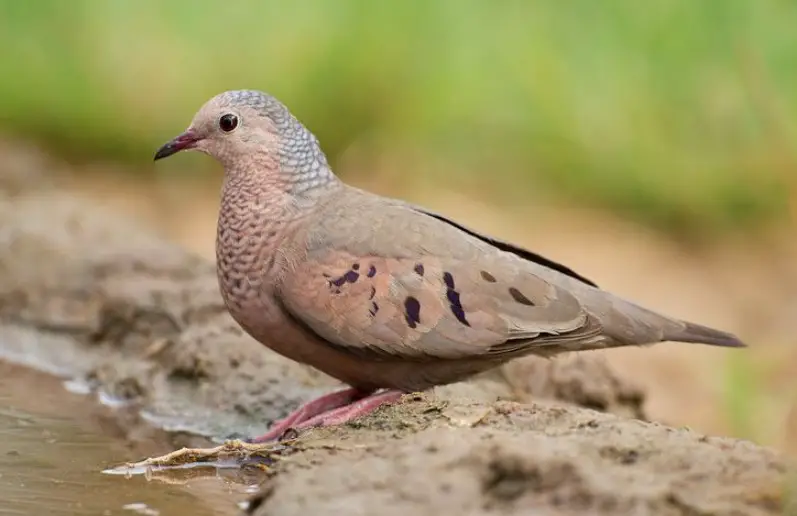
The Common Ground Dove is an extremely rare species in North Carolina, recorded only occasionally in the coastal plain. It is one of the smallest doves in North America, measuring just 6 to 7 inches in length with a wingspan of about 11 inches. This tiny dove has a short, rounded tail, scaly-looking gray-brown plumage, and rusty-colored wing patches visible in flight.
As their name suggests, these doves prefer open ground habitats such as sandy fields, scrublands, and coastal dunes. They forage mainly on the ground, eating seeds, small fruits, and occasionally insects. Their movements are usually short, fluttery flights close to the ground, and they often rely on camouflage to avoid predators rather than long-distance flying.
Their call is a distinctive soft, mournful cooing that sounds like a drawn-out “wooo.” During courtship, males perform short aerial displays and bowing behaviors while cooing to attract females. Nesting usually takes place on or very near the ground, where they build shallow scrapes lined with vegetation. Like other doves, they typically lay two white eggs.
A fun fact about the Common Ground Dove is that despite their small size, they are remarkably hardy and capable of surviving in dry, open environments. Their presence in North Carolina is always a noteworthy event for birders, as they are more common in the southern U.S. and along the Gulf Coast.
Passenger Pigeon (Ectopistes migratorius)
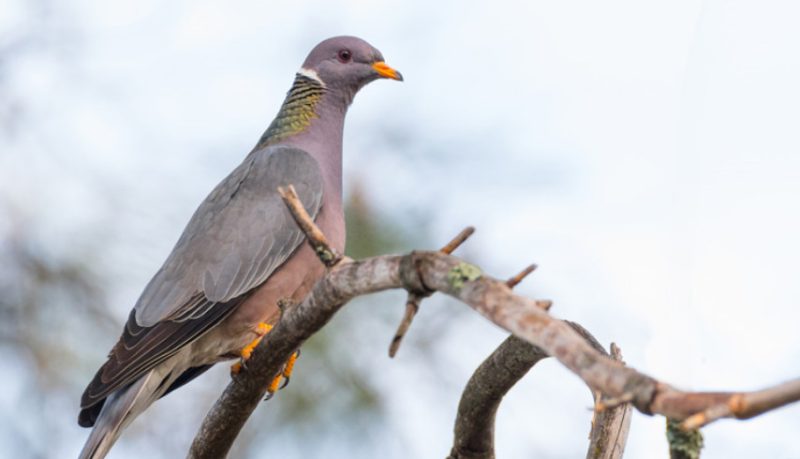
The Passenger Pigeon once dominated North America, including North Carolina, with flocks so enormous they could darken the sky for hours as they passed. Adults measured about 15 to 16 inches in length with long, pointed tails and slender bodies, resembling Mourning Doves but larger. Males were striking with reddish breasts and iridescent neck feathers, while females were duller gray-brown.
Passenger Pigeons were highly social, nesting and feeding in immense colonies numbering in the millions. They fed primarily on acorns, beechnuts, chestnuts, and other forest mast, moving nomadically in search of food. Their flight was swift and graceful, and they could cover enormous distances with ease.
Their calls were a series of harsh clucks and coos, quite different from the gentle cooing of modern doves. Breeding colonies were massive, with thousands of nests packed closely together in trees. Females laid one egg per nest, and both parents fed the chick with crop milk. These communal nesting sites could stretch for miles.
A fun fact—though bittersweet—is that Passenger Pigeons were once the most numerous bird species on Earth, with billions in their population. However, relentless hunting and habitat loss led to their rapid extinction by the early 20th century, with the last known individual, “Martha,” dying in captivity in 1914. Today, their memory serves as a powerful conservation lesson.
Inca Dove (Columbina inca)

The Inca Dove is a small, slender dove that is considered a very rare visitor in North Carolina, usually appearing in the southern United States and Mexico. Measuring only about 8 inches in length with an 11-inch wingspan, it is smaller than a Mourning Dove but slightly larger than a Common Ground Dove. Its most distinctive feature is its scaly-looking plumage, with pale gray-brown feathers edged in darker tones that give a delicate, patterned appearance.
These doves prefer open habitats such as suburban neighborhoods, parks, farmlands, and scrubby areas where they can forage on the ground. Their diet consists mainly of small seeds and grains, which they peck from bare soil or short grasses. They often forage in pairs or small groups and are known for their fluttery, weak-looking flight, which contrasts with the strong wingbeats of larger dove species.
The call of the Inca Dove is a soft, mournful “coo” that rises and falls in a rhythmic pattern. During courtship, males perform short display flights and bowing displays to attract females. Nests are flimsy structures of twigs placed in trees, shrubs, or even on man-made structures. Like other doves, the female typically lays two white eggs, and both parents take turns incubating and feeding the chicks.
A fun fact about the Inca Dove is that in cooler weather, they are known to huddle together in tight groups—sometimes called “feathered chains”—to conserve warmth. While sightings in North Carolina are rare, they are memorable for birders lucky enough to spot this delicately patterned species.
FAQs about Doves in North Carolina
What types of doves can be found in North Carolina?
North Carolina is home to several dove and pigeon species, including the Mourning Dove, Rock Pigeon, Eurasian Collared-Dove, and White-winged Dove. Rare visitors such as the Band-tailed Pigeon, Common Ground Dove, and Inca Dove have also been recorded. Historically, the now-extinct Passenger Pigeon was once common in the state.
How can I identify a Mourning Dove?
Mourning Doves are slender, medium-sized birds with gray-brown plumage, black wing spots, and long, pointed tails edged with white. They are often seen perched on wires or foraging on the ground in fields and suburban areas.
Are Rock Pigeons native to North Carolina?
No, Rock Pigeons are not native. They were introduced from Europe centuries ago and have adapted well to city life. They are now common in urban and rural areas across North Carolina.
What makes the Eurasian Collared-Dove unique?
This dove is easily identified by its pale gray body and a distinctive black collar on the back of its neck. It is a relatively new species in North Carolina, having spread rapidly across the United States since the late 20th century.
Are White-winged Doves common in North Carolina?
White-winged Doves are uncommon but occasionally seen in North Carolina, especially during migration. They are recognized by their gray-brown plumage, bold white wing patches, and blue eye-ring.
What is special about the Band-tailed Pigeon?
The Band-tailed Pigeon is a rare visitor in North Carolina and is considered the closest living relative of the extinct Passenger Pigeon. It is large, with a pale gray band on its tail and a distinctive white crescent on the back of its neck.
How rare is the Common Ground Dove in North Carolina?
The Common Ground Dove is very rare in the state, with sightings usually limited to coastal plains. It is one of the smallest doves in North America, with a short tail and scaly-looking plumage.
Do Inca Doves live in North Carolina?
Inca Doves are extremely rare in North Carolina, though they occasionally appear. They are small doves with a unique scaly feather pattern and a soft, rising-and-falling coo.
What happened to the Passenger Pigeon?
The Passenger Pigeon was once the most abundant bird in North America, including North Carolina, but went extinct in the early 20th century due to overhunting and habitat loss. The last known bird, named Martha, died in 1914.
What do doves eat in North Carolina?
Most doves feed primarily on seeds and grains, though they may also eat fruits and small invertebrates. They are commonly seen foraging on the ground or visiting backyard feeders.
What sounds do doves make?
Different dove species have unique calls. Mourning Doves make a soft, mournful “coo-OO-oo,” while Eurasian Collared-Doves have a three-part “coo-COO-coo.” Rock Pigeons and Band-tailed Pigeons produce deeper cooing sounds, while the Inca Dove’s call rises and falls in rhythm.
When is the best time to see doves in North Carolina?
Mourning Doves, Rock Pigeons, and Eurasian Collared-Doves are year-round residents. Other species, like White-winged Doves and Band-tailed Pigeons, are occasional visitors, and the best chance to see them is during migration seasons in spring and fall.


